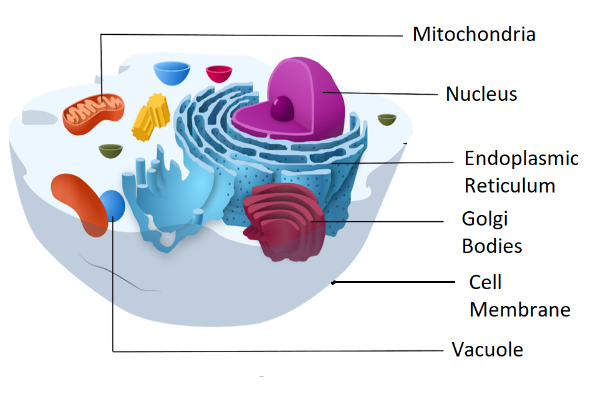
Draw a diagram of a typical cell and label the following parts in it
1)Cell membrane
2)Vacuole
3)Nucleus
4)Endoplasmic reticulum
5)Mitochondria
6)Golgi body
Answer
458.1k+ views
Hint: Cell is the basic structural and functional unit of all organisms. It is the smallest unit of life. They are generally known as the building blocks of life.
Complete answer:
A cell membrane is a semi-permeable membrane of a cell that surrounds and holds the contents in the cytoplasm and nucleus. It separates the cell from the interstitial fluids. The main function of the cell membrane is to provide protection. And also it helps in the transport of nutrients.
Vacuole is generally termed as the space within the cell which is lined with membrane and is filled with fluid. They perform the main functions such as storage, ingestion, digestion, excretion and expulsion of the excess water. It also helps to maintain the water balance.
Nucleus is generally a membrane bound organelle that consists of the genetic material that is DNA. It helps to maintain the integrity of the cell through facilitating transcription and replication process. It is the largest organelle which is found in cells. The main function of the nucleus includes the following, it coordinates the cell activities like protein synthesis and the cell division.
Endoplasmic reticulum is a continuous membrane system which forms a series of flattened sacs inside the cytoplasm. The main function of the endoplasmic reticulum is to provide the proteins for the rest of the cell to function properly.
Mitochondria is a double membrane bound organelle which is mostly found in eukaryotic organisms. They are present in nearly all types of human cells. They generate the majority of adenosine triphosphate ATP and are also involved in the signaling between the cells. Generally they are known as the powerhouse of the cell.
The Golgi body is also known as the Golgi complex which is an organelle found in most of the eukaryotic cells. It helps to process and package proteins and also lipid molecules.

Note: Cells are the building blocks of the living organism. They provide structure to the body, take nutrients from the food and help to convert that nutrients as energy. These are the most important functions of the cell.
Complete answer:
A cell membrane is a semi-permeable membrane of a cell that surrounds and holds the contents in the cytoplasm and nucleus. It separates the cell from the interstitial fluids. The main function of the cell membrane is to provide protection. And also it helps in the transport of nutrients.
Vacuole is generally termed as the space within the cell which is lined with membrane and is filled with fluid. They perform the main functions such as storage, ingestion, digestion, excretion and expulsion of the excess water. It also helps to maintain the water balance.
Nucleus is generally a membrane bound organelle that consists of the genetic material that is DNA. It helps to maintain the integrity of the cell through facilitating transcription and replication process. It is the largest organelle which is found in cells. The main function of the nucleus includes the following, it coordinates the cell activities like protein synthesis and the cell division.
Endoplasmic reticulum is a continuous membrane system which forms a series of flattened sacs inside the cytoplasm. The main function of the endoplasmic reticulum is to provide the proteins for the rest of the cell to function properly.
Mitochondria is a double membrane bound organelle which is mostly found in eukaryotic organisms. They are present in nearly all types of human cells. They generate the majority of adenosine triphosphate ATP and are also involved in the signaling between the cells. Generally they are known as the powerhouse of the cell.
The Golgi body is also known as the Golgi complex which is an organelle found in most of the eukaryotic cells. It helps to process and package proteins and also lipid molecules.

Note: Cells are the building blocks of the living organism. They provide structure to the body, take nutrients from the food and help to convert that nutrients as energy. These are the most important functions of the cell.
Recently Updated Pages
Master Class 9 General Knowledge: Engaging Questions & Answers for Success

Master Class 9 English: Engaging Questions & Answers for Success

Master Class 9 Science: Engaging Questions & Answers for Success

Master Class 9 Social Science: Engaging Questions & Answers for Success

Master Class 9 Maths: Engaging Questions & Answers for Success

Class 9 Question and Answer - Your Ultimate Solutions Guide

Trending doubts
State and prove Bernoullis theorem class 11 physics CBSE

Who built the Grand Trunk Road AChandragupta Maurya class 11 social science CBSE

1 ton equals to A 100 kg B 1000 kg C 10 kg D 10000 class 11 physics CBSE

State the laws of reflection of light

One Metric ton is equal to kg A 10000 B 1000 C 100 class 11 physics CBSE

Difference Between Prokaryotic Cells and Eukaryotic Cells




